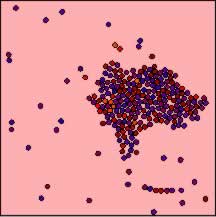

We finish the first half of the semester by studying how molecular dynamics models based on classical mechanics give rise to macroscopic phenomena. Students turn in their mid-term projects at the end of the week.
The Molecular Dynamics Demonstration Model stored data files that lets users select 24 different initial configurations from a drop down menu.
Initial conditions are from Dan Schroeder with suggestions from John John Mallinckrodt. Configurations include:
Uses may adjust the animation speed to control the number of frames displayed per second but this parameter does not change the time step in the Verlet algorithm. The time step in each configuration has been chosen to conserve energy. Uses can drag atoms within the simulation to modify the conditions.
The following models use the Lennard-Jones potential to model molecular dynamics.
Additional models may be be posted for self-study.
The Lennard-Jones Molecular Dynamics Demo Model was created for teaching computer modeling by Wolfgang Christian using the Easy Java Simulations (EJS) version 4.1 authoring and modeling tool. It is based on a Java applet written by Dan Schroeder, Physics Department, Weber State University. See: <http://physics.weber.edu/schroeder/software/>
You can examine and modify a compiled EJS model if you run the model (double click on the model's jar file), right-click within a plot, and select "Open Ejs Model" from the pop-up menu. You must, of course, have EJS installed on your computer. Information about Ejs is available at: <http://www.um.es/fem/Ejs/> and in the OSP comPADRE collection <http://www.compadre.org/OSP/>.